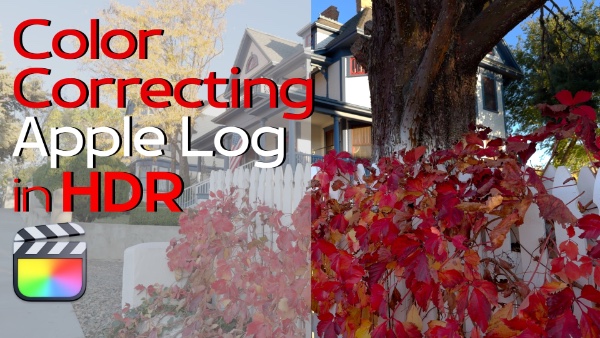Creating a Grad Filter Effect in Final Cut Pro X
In Under 5 Minutes, Steve Martin will teach you how to use a gradient generator and a few blend modes to emulate a grad filter look in Final Cut Pro X.
This creative photography influenced editing technique can be used to saturate or desaturate a skyline, lighten or darken subject matter, alter ‘exposure’, or simulate any kind of neutral density or graduated color effect. Subscribe to our channel to receive our free tips and tricks every Monday!
Welcome to Final Cut Pro X in Under 5 Minutes, I’m Steve from RippleTraining.com. In this episode, I’m going to show you how to emulate a grad filter effect that’s been popular with photographers for many years.
During a shoot, a grad filter is placed in front of the lens. Like the name suggests, it’s called a grad because the glass graduates from color on one side to clear on the other.
This allows the photographer to change one part of the frame without changing another.
We can re-create this looks in Final Cut Pro by using a gradient and a few blend modes.
In the timeline, I placed a video clip from a recent shoot. It also has some basic color correction applied to improve the overall contrast.
I’ll duplicate the clip by option-dragging upward, then select either clip and press X to set a range.
Next, I’ll open the Generators browser, locate the Gradient, then press Q to connect it above the others while matching their durations.
With the gradient selected, open the Inspector, and reveal the Generator controls.
I’ll change the bottom color of the gradient to pure black,
and the top color of the gradient to pure white.
In the viewer use the on-screen controls to adjust the gradients position to roughly half the frame.
In the timeline drag the gradient downward so its sandwiched between the two video clips.
In order to see the effect the gradient will have on the bottom clip, disable the top clip by selecting it and pressing V.
I’m about to use the gradient as a matte to reveal only a portion of the clip below it.
With the gradient selected, click the video button then in the compositing section, choose blend mode > Stencil Luma.
Final Cut Pro uses the white pixels as Luma Matte to reveal the top part of the image wherever the pixels are the brightest.
Gray pixels as semi-transparent and black pixies are treated as opaque.
Using the on-screen controls. you can reveal more or less of the image. You can ask adjust the angle to account for skies and other backgrounds that are not parallel to the subject or foreground.
To create the grad effect, select the bottom clip, then press Command-6 to open the color board.
Using the global control, I’ll select a purplish color for the sky.
In this case, I’m going for a creative look, not necessary a realistic one.
Let’s composite in the top clip by selecting it, and pressing V to re-enable it.
As you learned in episode 6 “Video in Text Effects” I need to change the processing order of the clip so that it appears behind the Luma matted clip, and uses the black pixels of the gradient for transparency.
I’ll return to the video pane, then from the Blend Mode popup, I’ll choose Behind.
To have the gradient interact with the final composite and see your changes update in the viewer, select the gradient clip and adjust the controls to your liking.
If you want to change the color of the grad, select the bottom clip, open the color board and choose a new color.
You can even desaturate part of the image or change exposure.
Using a gradient gives you a ton of creative control.
If you like this tutorial and want to learn more, we have a complete color correction tutorial on our website that’s full of real world advice and creative techniques.
During a shoot, a grad filter is placed in front of the lens. Like the name suggests, it’s called a grad because the glass graduates from color on one side to clear on the other.
This allows the photographer to change one part of the frame without changing another.
We can re-create this looks in Final Cut Pro by using a gradient and a few blend modes.
In the timeline, I placed a video clip from a recent shoot. It also has some basic color correction applied to improve the overall contrast.
I’ll duplicate the clip by option-dragging upward, then select either clip and press X to set a range.
Next, I’ll open the Generators browser, locate the Gradient, then press Q to connect it above the others while matching their durations.
With the gradient selected, open the Inspector, and reveal the Generator controls.
I’ll change the bottom color of the gradient to pure black,
and the top color of the gradient to pure white.
In the viewer use the on-screen controls to adjust the gradients position to roughly half the frame.
In the timeline drag the gradient downward so its sandwiched between the two video clips.
In order to see the effect the gradient will have on the bottom clip, disable the top clip by selecting it and pressing V.
I’m about to use the gradient as a matte to reveal only a portion of the clip below it.
With the gradient selected, click the video button then in the compositing section, choose blend mode > Stencil Luma.
Final Cut Pro uses the white pixels as Luma Matte to reveal the top part of the image wherever the pixels are the brightest.
Gray pixels as semi-transparent and black pixies are treated as opaque.
Using the on-screen controls. you can reveal more or less of the image. You can ask adjust the angle to account for skies and other backgrounds that are not parallel to the subject or foreground.
To create the grad effect, select the bottom clip, then press Command-6 to open the color board.
Using the global control, I’ll select a purplish color for the sky.
In this case, I’m going for a creative look, not necessary a realistic one.
Let’s composite in the top clip by selecting it, and pressing V to re-enable it.
As you learned in episode 6 “Video in Text Effects” I need to change the processing order of the clip so that it appears behind the Luma matted clip, and uses the black pixels of the gradient for transparency.
I’ll return to the video pane, then from the Blend Mode popup, I’ll choose Behind.
To have the gradient interact with the final composite and see your changes update in the viewer, select the gradient clip and adjust the controls to your liking.
If you want to change the color of the grad, select the bottom clip, open the color board and choose a new color.
You can even desaturate part of the image or change exposure.
Using a gradient gives you a ton of creative control.
If you like this tutorial and want to learn more, we have a complete color correction tutorial on our website that’s full of real world advice and creative techniques.





